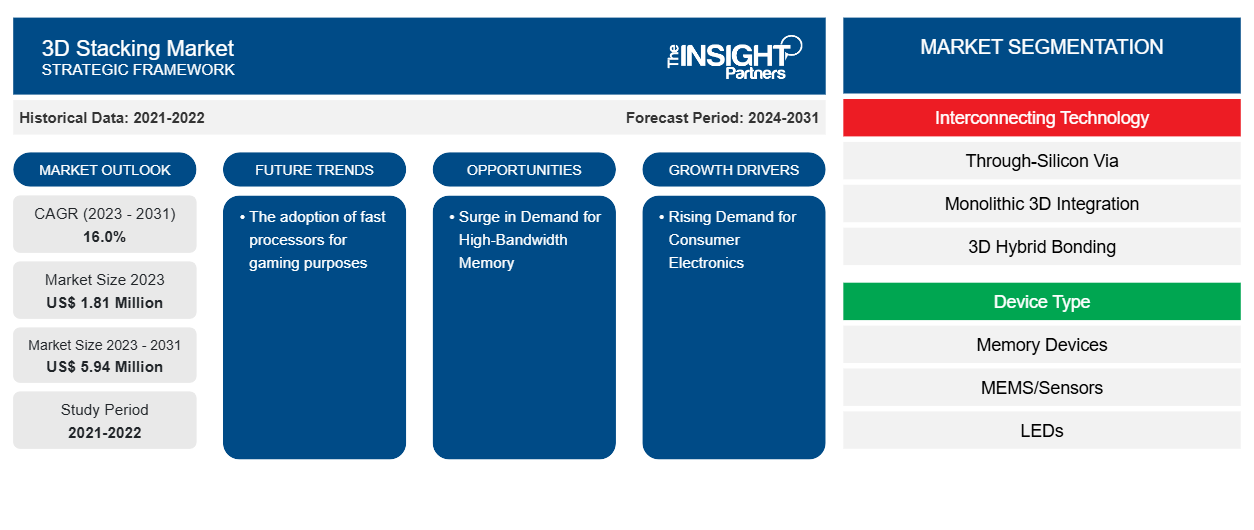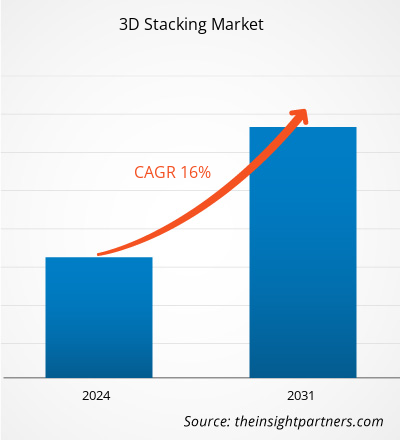The 3D stacking market size is expected to reach US$ 5.94 billion by 2031 from US$ 1.81 billion in 2023. The market is estimated to record a CAGR of 16.0% from 2023 to 2031. The adoption of fast processors for gaming purposes is likely to remain a key market trend.
3D Stacking Market Analysis
Shorter interconnects within a 3D stacked configuration result in reduced power consumption and improved signal integrity, making it an attractive solution for energy-efficient and high-performance applications. The growing adoption of 3D stacking technology is a key factor contributing to the 3D stacking market growth. This technology allows for the stacking of dies on a substrate, creating chips in packages that are smaller and more energy-efficient. Additionally, 3D stacking technology facilitates the development of innovative, feature-rich products, particularly in the consumer electronics sector. The ability to stack memory and logic components vertically allows for the creation of more powerful and compact devices—which align with the market demand for sleek, high-performance gadgets.
3D Stacking Market Overview
3D stacking technology represents a transformative advancement in the field of semiconductor packaging, offering a paradigm shift in the way electronic components are integrated and interconnected. This cutting-edge technology involves vertically stacking multiple integrated circuit (IC) layers, typically using through-silicon vias (TSVs) to establish connections between the stacked layers. 3D stacking technology holds the potential to revolutionize product design and performance across various industries to achieve superior functionality in a more compact form factor. Furthermore, this technology empowers businesses to stay at the forefront of technological innovation, fostering a competitive position in the rapidly evolving landscape of electronic devices and semiconductor solutions. 3D stacking technology enables the efficient integration of disparate components, such as memory, logic, and sensors, into a single package, leading to enhanced performance and reduced footprint. This technology helps in providing streamlined manufacturing processes, optimized supply chain management, and cost savings.
Customize This Report To Suit Your Requirement
You will get customization on any report - free of charge - including parts of this report, or country-level analysis, Excel Data pack, as well as avail great offers and discounts for start-ups & universities
3D Stacking Market: Strategic Insights

-
Get Top Key Market Trends of this report.This FREE sample will include data analysis, ranging from market trends to estimates and forecasts.
3D Stacking Market Drivers and Opportunities
Rising Demand for Consumer Electronics to Favor Market
The proliferating demand for sleek, feature-rich, and power-efficient gadgets such as smartphones, tablets, smartwatches, and portable devices has led to immense pressure on manufacturers to deliver compact, high-performance solutions. For instance, according to Omdia data published in February 2024, the preliminary shipment of smartphones was 328 million units in the fourth quarter of 2023. This represents 8.6% gain over 4Q22, establishing 4Q23 as the first quarter to show major growth since 2Q21. Consumers across the globe are highly adopting smartphones for shopping, communication, entertainment, and other purposes. These devices use 3D stacked die packaging, which is revolutionizing their designs and functionality. 3D stacked die packaging is capable of significantly reducing form factors without compromising performance. By vertically stacking multiple layers of integrated circuits, this technology allows for the smooth integration of diverse components within a compact space. This consolidation not only streamlines the design and assembly processes but also enables manufacturers to create thin, more aesthetically appealing devices that align with the evolving preferences of consumers.
Surge in Demand for High-Bandwidth Memory
High-bandwidth memory (HBM), which reaches extremely high density by stacking numerous dynamic random access memory (DRAMs) vertically, is distinguished by rapid data processing and low power consumption. It is essential in high-performance computing (HPC), such as generative AI, which requires processing enormous amounts of data at significantly fast speeds. Samsung Electronics 12-layer stacked HBM uses next-generation 3D stacking packaging technique to boost performance and yield. With a processing speed of 6.4Gbps and a bandwidth of 819 GB/s, HBM3 is 1.8 times faster than the previous-generation DRAM while using 10% less power. The demand for HBM in high-performance computing applications encourages market players to increase their production. For instance, in March 2024, SK HYNIX INC started volume production of HBM3E1, the newest AI memory product with ultra-high performance. HBM3E is designed for an AI system that processes a huge amount of data quickly. The high-bandwidth memory is used by various industries, including telecommunication, automotive, healthcare, and manufacturing, for high-speed data processing.
3D Stacking Market Report Segmentation Analysis
Key segments that contributed to the derivation of the 3D stacking market analysis are technology, device type, and end user.
- Based on technology, the 3D stacking market is segmented into through-silicon via, monolithic 3D integration, and 3d hybrid bonding. The through-silicon via segment held a larger market share in 2023.
- Based on device type, the 3D stacking market is segmented into memory devices, mems/sensors, leds, imaging & optoelectronics, and others. The memory devices segment dominated the market in 2023.
- In terms of end user, the 3D stacking market is segmented into consumer electronics, telecommunication, automotive, manufacturing, healthcare, and others. The consumer electronics segment dominated the market in 2023.
3D Stacking Market Share Analysis by Geography
- The 3D stacking market is segmented into five major regions—North America, Europe, Asia Pacific (APAC), the Middle East & Africa (MEA), and South & Central America. Asia Pacific dominated the market in 2023, followed by North America and Europe.
- The 3D stacking market growth in Asia Pacific is attributed to the growing deman from semiconductor manufacturing and consumer electronics. According to the Asia Pacific Foundation, China and Taiwan have significantly boosted investments in chip manufacturing, which is also expected to benefit South Korea and Japan. Also, the Taiwan Semiconductor Manufacturing Company planned to set up its first factory in Japan, which aligned with the Japanese Prime Minister's agenda of prioritizing semiconductor manufacturing to further expand domestic supply chains. Moreover, expanding of the semiconductor manufacturing and consumer electronics industries are anticipated to create lucrative opportunities for the market growth during the forecast period.
3D Stacking Market Regional Insights
The regional trends and factors influencing the 3D Stacking Market throughout the forecast period have been thoroughly explained by the analysts at The Insight Partners. This section also discusses 3D Stacking Market segments and geography across North America, Europe, Asia Pacific, Middle East and Africa, and South and Central America.
3D Stacking Market Report Scope
| Report Attribute | Details |
|---|---|
| Market size in 2023 | US$ 1.81 Million |
| Market Size by 2031 | US$ 5.94 Million |
| Global CAGR (2023 - 2031) | 16.0% |
| Historical Data | 2021-2022 |
| Forecast period | 2024-2031 |
| Segments Covered |
By Interconnecting Technology
|
| Regions and Countries Covered |
North America
|
| Market leaders and key company profiles |
|
3D Stacking Market Players Density: Understanding Its Impact on Business Dynamics
The 3D Stacking Market is growing rapidly, driven by increasing end-user demand due to factors such as evolving consumer preferences, technological advancements, and greater awareness of the product's benefits. As demand rises, businesses are expanding their offerings, innovating to meet consumer needs, and capitalizing on emerging trends, which further fuels market growth.

- Get the 3D Stacking Market top key players overview
3D Stacking Market News and Recent Developments
The 3D stacking market is evaluated by gathering qualitative and quantitative data post primary and secondary research, which includes important corporate publications, association data, and databases. A few of the developments in the 3D stacking market are listed below:
- Intel researchers showcased advancements in 3D stacked complementary metal oxide semiconductor (CMOS) transistors combined with backside power and direct backside contacts at the 2023 IEEE International Electron Devices Meeting (IEDM). The company also reported on scaling paths for recent R&D breakthroughs for backside power delivery, such as backside contacts, and it was the first to demonstrate successful large-scale 3D monolithic integration of silicon transistors with gallium nitride (GaN) transistors on the same 300-millimeter (mm) wafer, rather than on the package. (Source: Intel Corp, Press Release, December 2023)
3D Stacking Market Report Coverage and Deliverables
The "3D Stacking Market Size and Forecast (2021–2031)" provides a detailed analysis of the market covering the areas mentioned below:
- 3D stacking market size and forecast at global, regional, and country levels for all the key market segments covered under the scope
- 3D stacking market trends as well as market dynamics such as drivers, restraints, and key opportunities
- Detailed PEST/Porter’s Five Forces and SWOT analysis
- 3D stacking market analysis covering key market trends, global and regional framework, major players, regulations, and recent market developments
- Industry landscape and competition analysis covering market concentration, heat map analysis, prominent players, and recent developments for the 3D stacking market
- Detailed company profiles
Frequently Asked Questions
Which are the leading players operating in the 3D stacking market?
Which region dominated the 3D stacking market in 2023?
What are the driving factors impacting the 3D stacking market?
What is the expected CAGR of the 3D stacking market?
What would be the estimated value of the 3D stacking market by 2031?
What are the future trends of the 3D stacking market?
- Historical Analysis (2 Years), Base Year, Forecast (7 Years) with CAGR
- PEST and SWOT Analysis
- Market Size Value / Volume - Global, Regional, Country
- Industry and Competitive Landscape
- Excel Dataset
Recent Reports
Related Reports
Testimonials
Reason to Buy
- Informed Decision-Making
- Understanding Market Dynamics
- Competitive Analysis
- Identifying Emerging Markets
- Customer Insights
- Market Forecasts
- Risk Mitigation
- Boosting Operational Efficiency
- Strategic Planning
- Investment Justification
- Tracking Industry Innovations
- Aligning with Regulatory Trends





















 Get Free Sample For
Get Free Sample For